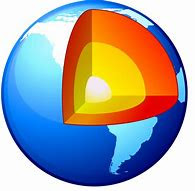Lithosphere
1. Lithosphere.
- The lithosphere is the rigid, outermost layer of the Earth. It is composed of the crust and the portion of the upper mantle that behaves elastically on time scales of thousands of years or greater. It is an average of 100km thick. The lithosphere is the outermost layer, meaning its outer boundary is the atmosphere, hydrosphere and biosphere. The inner boundary of the lithosphere is the asthenosphere, which is a plastic-like layer of the mantle that the lithosphere "floats" on. The outermost layer of a rocky planet, the crust, is defined on the basis of its chemistry and mineralogy.
- This includes the crust and the uppermost mantle, which constitute the hard and rigid outer layer of the Earth. The uppermost part of the lithosphere that chemically reacts to the atmosphere, hydrosphere and biosphere through the soil-forming process is called the pedosphere.
- Continents and oceans are located in the lithosphere. The lithosphere consists of two parts.
1.Earth's Crust
2.Upper mantle
1.Earth's Crust
- Earth's crust is the upper rigid part of the lithosphere, the base of which is defined by a prominent seismic discontinuity or Moho. Earth's crust is composed of igneous, metamorphic and sedimentary rocks. The most abundant rocks in the crust are igneous, which are formed by the cooling of magma. Earth's crust is rich in igneous rocks such as granite and basalt. Earth's crust is divided into two types.
- Continental Crust
- Continental crust, the outermost layer of Earth's lithosphere that makes up the planet’s continents and continental shelves and is formed near subduction zones at plate boundaries between continental and oceanic tectonic plates. The continental crust forms nearly all of Earth’s land surface. Continental crust is typically 40 km (25 miles) thick, while oceanic crust is much thinner, averaging about 6 km (4 miles) in thickness.
- Oceanic Crust
- Oceanic crust, the outermost layer of Earth's lithosphere that is found under the oceans and formed at spreading sheets on oceanic rigids, which occur at divergent plate boundaries. Oceanic crust is about 6 km (4 miles) thick. It is composed of several layers, not including the overlying sediment.
2. Upper mantle
- The upper mantle is a layer of the interior of the Earth. It extends from the crust to a depth of about 410 kilometers. The upper mantle is mostly solid, but its more malleable regions contribute to tectonic activity. Two parts of the upper mantle are often recognized as distinct regions in Earth's interior: the lithosphere and the asthenosphere.
- The lithosphere is the home for living beings. Most of the human activities occur here. The living and non-living resources which are found in the lithosphere are utilized to fulfil human needs.
- When the resources found in the lithosphere are utilized by man, the lithosphere is affected in various ways. Examples of such effects are shown below.
- The occurrence of land degradation due to excavation of land to obtain is mineral resources.
- Intensification of soil erosion as a result of exposure of land due to clearing of forests.
- Changes seen in the surface landscape.
- Changes in the ground water level.







Comments
Post a Comment